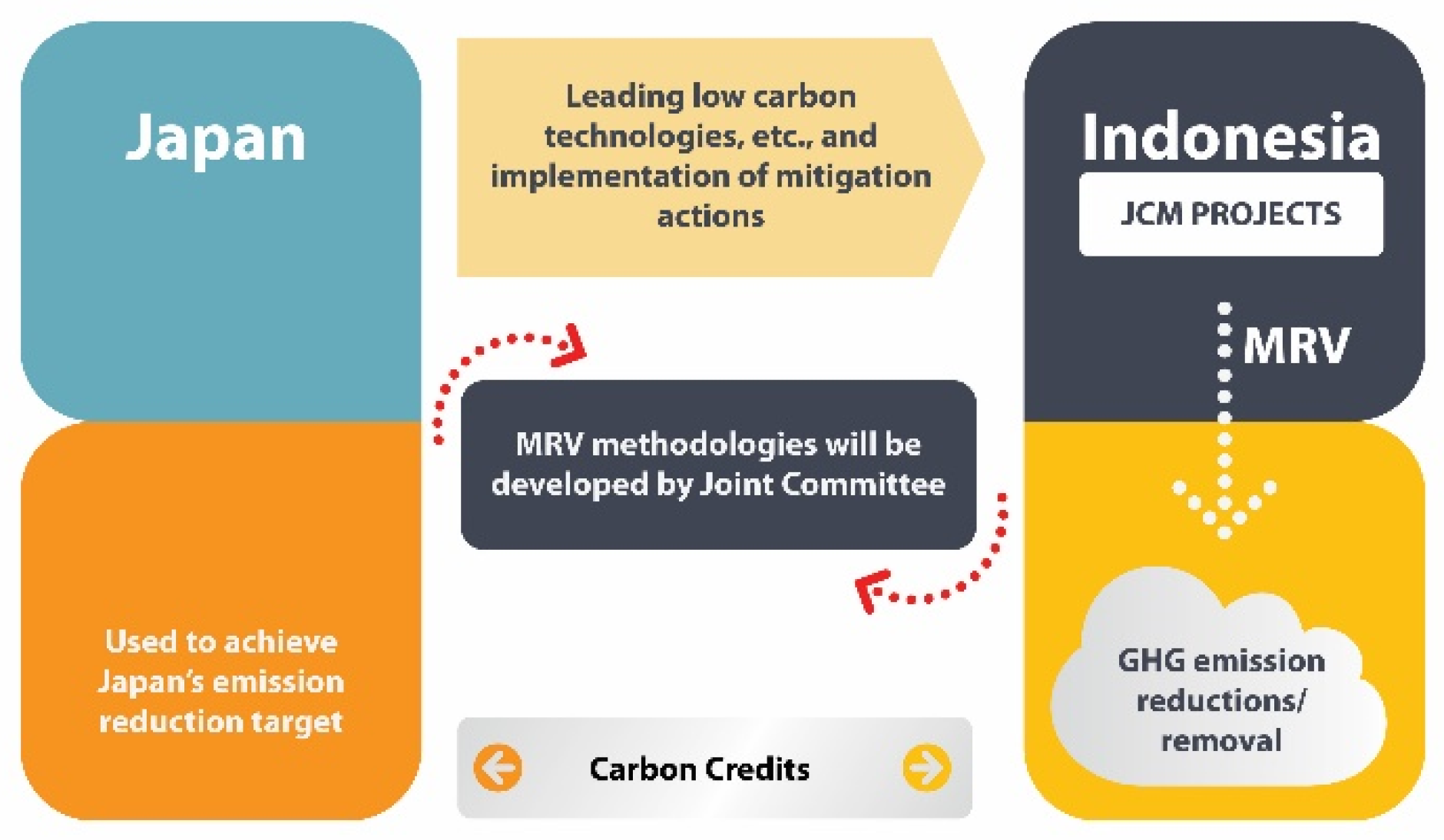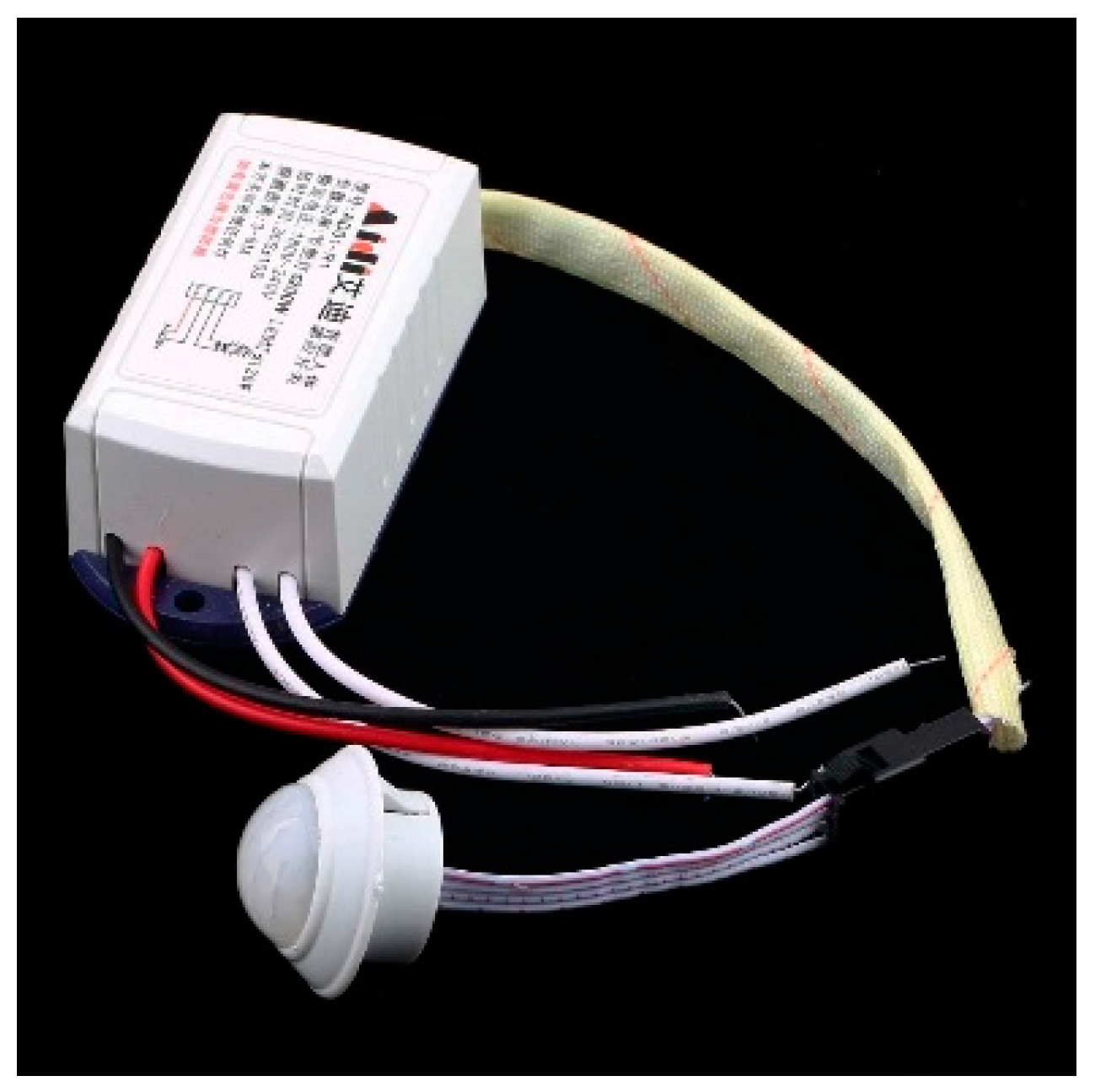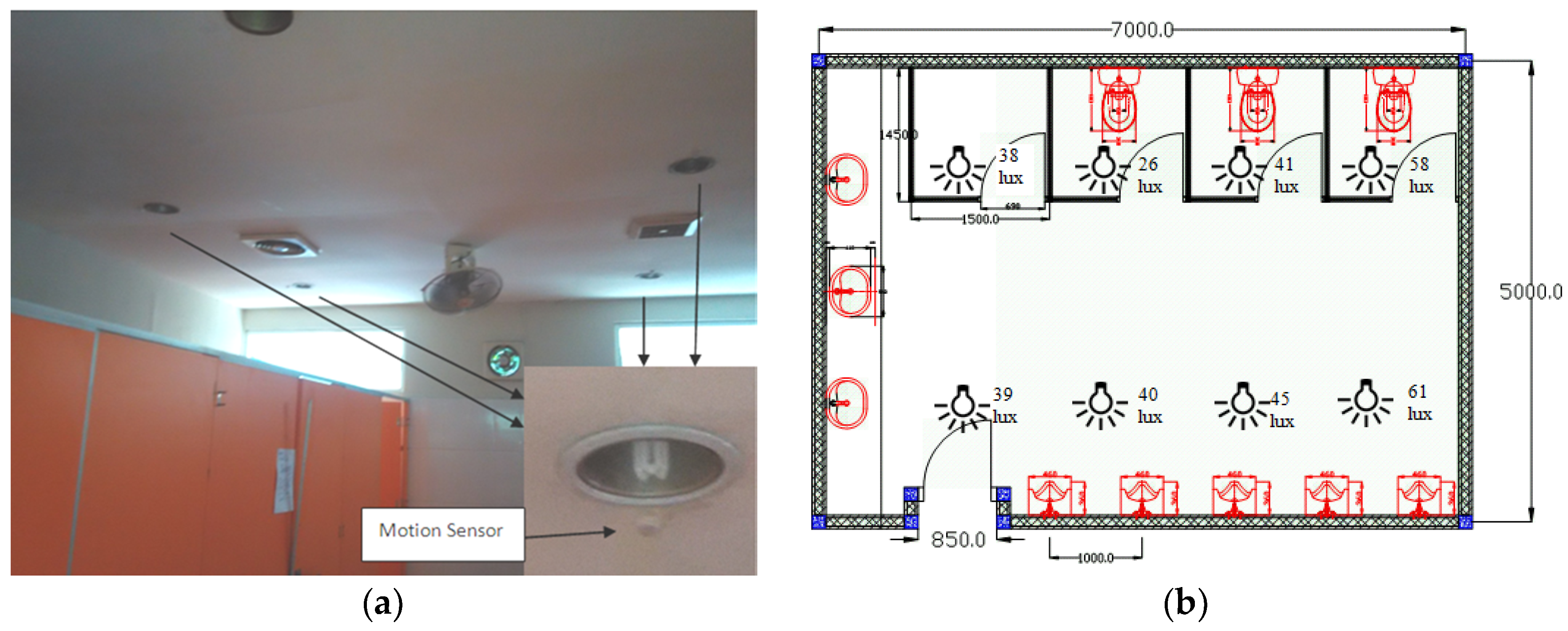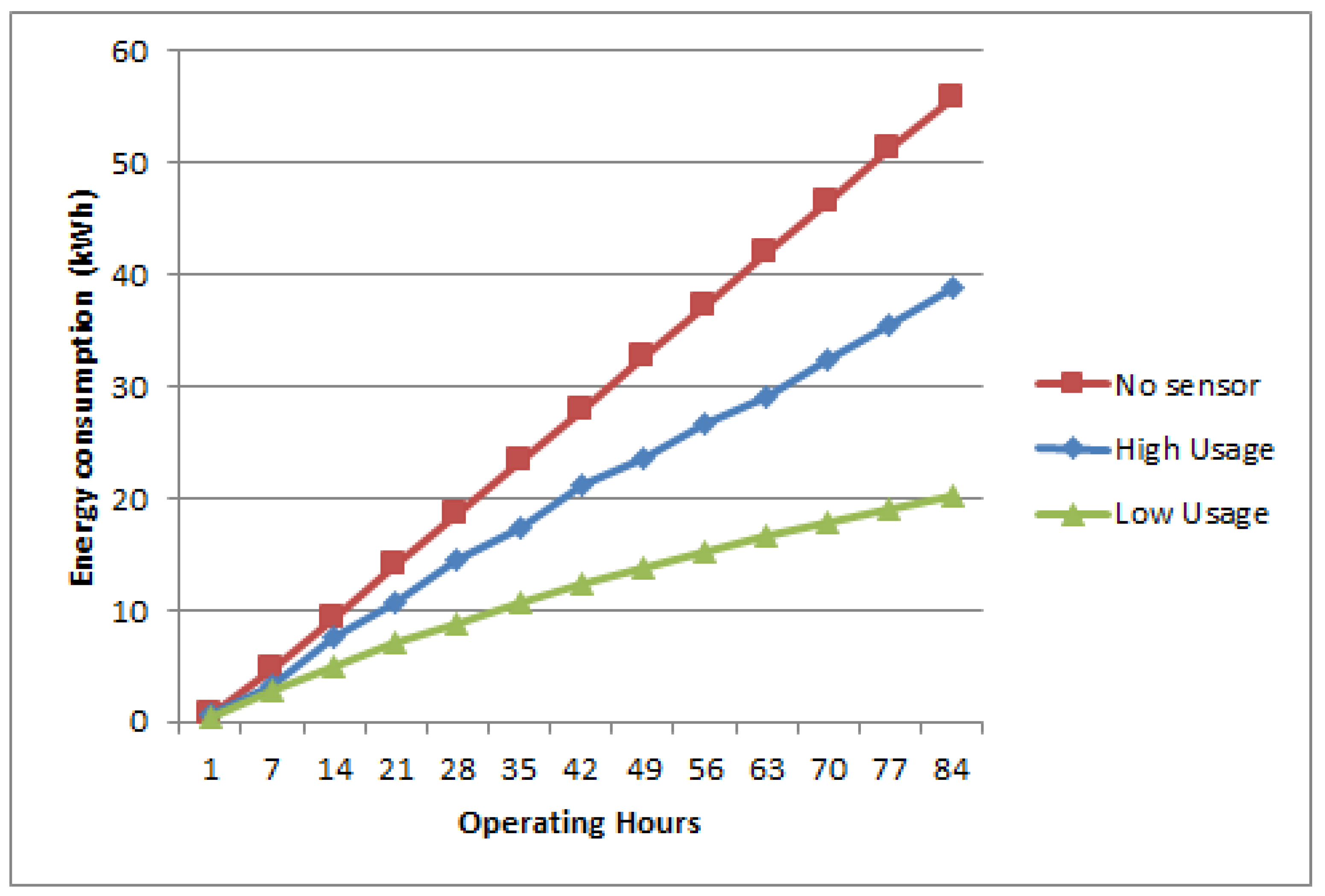Motion Sensor Application on Building Lighting Installation for Energy Saving and Carbon Reduction Joint Crediting Mechanism
Abstract
:1. Introduction
2. Materials and Methods
2.1. Motion Detection
2.2. Passive Infrared Sensor
2.3. Related Research
2.4. JCM Method
| REp | Reference emissions during the period p [tCO2/p] |
| ECPJ,p | Total power consumption of project lighting during the period p [MWh/p] |
| ηPJ | Luminous efficiency of project lighting [lm/W] |
| ηRE | Luminous efficiency of reference lighting [lm/W] |
| EFelec | CO2 emission factor for consumed electricity [tCO2/MWh] for Java and Bali is 0.84 |
- Equipment: Use lux meter which shows the readings of the measurement in illuminance. Record the model of the lux meter used for the measurement and its most recent record of the calibration;
- Measurement points: Illuminance readings are taken under each light at the height of 1 meter above the floor.
3. Results
4. Discussion
Author Contributions
Funding
Conflicts of Interest
References
- Martini; Riyanto, I.; Adiyarta, K.; Suparmoko, M. An Effort to Lower Electricity Bill in University Building by Automatic Lighting Switches Application. Pertan. J. Soc. Sci. Human. 2018, 26, 11–19. [Google Scholar]
- Jansson, G.; Schade, J.; Olofsson, T. Requirements management for thedesign of energy efficient buildings. J. Inform. Technol. Constr. (ITcon) 2013, 18, 321–337. [Google Scholar]
- Pisello, A.L.; Bobker, M.; Cotana, F. A Building Energy Efficiency Optimization Method by Evaluating the Effective Thermal Zones Occupancy. Energies 2012, 5, 5257–5278. [Google Scholar] [CrossRef] [Green Version]
- Riyanto, I.; Margatama, L.; Suparmoko, M.; Martini; Hindarto, D.E. University Contribution in Developing Country on Carbon Emission Reduction through Motion Sensor Application Pilot Project on Building Lighting Installation. In Proceedings of the IEEE International Conference on Applied System Innovation, Chiba, Japan, 13–17 April 2018. [Google Scholar]
- JCM Indonesia Secretariat. Installation of LED Lighting for Grocery Store; Version 2.0; JCM Indonesia Secretariat: Jakarta, Indonesia, 2015.
- Sahu, A.K.; Choubey, A. Motion Detection Surveillance System Using Background Subtraction Algorithm. Int. J. Adv. Res. Comput. Sci. Manag. Stud. 2013, 1, 58–65. [Google Scholar]
- Rakibe, R.S.; Patil, B.D. Background Subtraction Algorithm Based Human Motion Detection. Int. J. Sci. Res. Publ. 2013, 3, 3–6. [Google Scholar]
- Wibowo, T. Sensor Kehadiran Orang Sebagai Saklar Otomatis Suatu Ruangan. Undergraduate Thesis, Universitas Diponegoro, Semarang, Indonesia, 2011. [Google Scholar]
- Coulson, D. ZMOTION™—A New PIR Motion Detection Architecture; Zilog, Inc.: Milpitas, CA, USA, 2010; No. WP001703-1110. [Google Scholar]
- Roisin, B.; Bodart, M.; Deneyer, A.; D’Herdt, P. Lighting Energy Savings in Offices Using Different Control Systems and Their Real Consumption. Energy Build. 2008, 40, 514–523. [Google Scholar] [CrossRef]
- Garg, V.; Bansal, N.K. Smart Occupancy Sensors to Reduce Energy Consumption. Energy Build. 2000, 32, 81–87. [Google Scholar] [CrossRef]
- Riyanto, I.; Akbar, Y.M. Local Area Positioning System (LAPS) for Indoor Navigation and Tracking System and Building Electricity Energy Saving. Int. J. Simul. Syst. Sci. Technol. 2016, 17, 101–107. [Google Scholar]
- Gieseler, U.D.J.; Heidt, F.D.; Bier, W. Evaluation of The Cost Efficiency of an Energy Efficient Building. Renew. Energy J. 2004, 29, 369–376. [Google Scholar] [CrossRef]
- Petri, I.; Kubicki, S.; Rezgui, Y.; Guerriero, A.; Li, H. Optimizing Energy Efficiency in Operating Built Environment Assets through Building Information Modeling: A Case Study. Energies 2017, 10, 1167. [Google Scholar] [CrossRef]
- Treado, S.; Chen, Y. Saving Building Energy through Advanced Control Strategies. Energies 2013, 6, 4769–4785. [Google Scholar] [CrossRef] [Green Version]




| Duration (hours) | Electrical Power (kWh) | Energy Reduction (%) | |
|---|---|---|---|
| With Sensor | Without Sensor | ||
| 0.504 | 0.664 | 24.10 | |
| 7 | 2.711 | 4.648 | 41.67 |
| 14 | 5.058 | 9.296 | 45.59 |
| 21 | 7.158 | 13.944 | 48.66 |
| 28 | 8.890 | 18.592 | 52.18 |
| 35 | 10.622 | 23.24 | 54.29 |
| 42 | 12.264 | 27.888 | 56.02 |
| 49 | 13.816 | 32.536 | 57.54 |
| 56 | 15.278 | 37.184 | 58.91 |
| 63 | 16.651 | 41.832 | 60.20 |
| 70 | 17.933 | 46.48 | 61.42 |
| 77 | 19.126 | 51.128 | 62.59 |
| 84 | 20.229 | 55.776 | 63.73 |
© 2018 by the authors. Licensee MDPI, Basel, Switzerland. This article is an open access article distributed under the terms and conditions of the Creative Commons Attribution (CC BY) license (http://creativecommons.org/licenses/by/4.0/).
Share and Cite
Riyanto, I.; Margatama, L.; Hakim, H.; Martini; Hindarto, D.E. Motion Sensor Application on Building Lighting Installation for Energy Saving and Carbon Reduction Joint Crediting Mechanism. Appl. Syst. Innov. 2018, 1, 23. https://doi.org/10.3390/asi1030023
Riyanto I, Margatama L, Hakim H, Martini, Hindarto DE. Motion Sensor Application on Building Lighting Installation for Energy Saving and Carbon Reduction Joint Crediting Mechanism. Applied System Innovation. 2018; 1(3):23. https://doi.org/10.3390/asi1030023
Chicago/Turabian StyleRiyanto, Indra, Lestari Margatama, H. Hakim, Martini, and Dicky Edwin Hindarto. 2018. "Motion Sensor Application on Building Lighting Installation for Energy Saving and Carbon Reduction Joint Crediting Mechanism" Applied System Innovation 1, no. 3: 23. https://doi.org/10.3390/asi1030023





